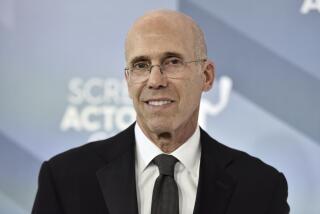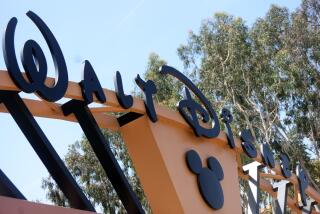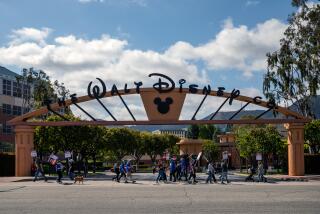DreamWorks Redraws Its Future
DreamWorks Studios, created by moguls Steven Spielberg, David Geffen and Jeffrey Katzenberg, revealed plans Wednesday to spin off its computer animation factory to the public, highlighting the shift by its founders away from the Hollywood powerhouse they envisioned a decade ago.
The move by the entertainment company behind the lucrative “Shrek” franchise would provide a way to reap much-needed cash through the sale of as much as $650 million in common stock. It also would financially fortify the company to compete against its two main rivals: “Finding Nemo” maker Pixar Animation Studios and Walt Disney Co., whose animation unit Katzenberg resuscitated as studio chief before he was forced out by Chief Executive Michael Eisner in 1994.
When Spielberg, Geffen and Katzenberg announced the creation of DreamWorks that same year, they hailed it as an entertainment conglomerate for the digital future, cutting across music, movies and television.
But since then, DreamWorks has sold its lackluster music label, closed its TV unit, shed its Internet aspirations and abandoned plans for a sprawling studio lot in the new Playa Vista development on the Westside. As a result, all that essentially would remain of the original vision is the company’s live-action studio, headed by Spielberg, which produced the current releases “Anchorman” and “The Terminal.”
The proposed public offering underscores how computer animation, barely on DreamWorks’ radar screen when it was founded, has become by far its most valuable asset as audiences flock to the dazzling high-tech genre. But it also illustrates the dramatic narrowing of the company’s once-huge ambitions.
DreamWorks’ three principals now are hoping their investments will pay off in a big way through the creation of the new DreamWorks Animation Inc.
“They are morphing very much into what Pixar is,” said Santa Monica investment banker Michael Montgomery, a former top financial executive with DreamWorks. “They have already moved into it, and this just validates that move.”
Katzenberg and Geffen would control the animation studio through a special class of voting shares, according to a Securities and Exchange Commission filing by the company. Spielberg’s role is expected to be more limited as he continues to focus on live-action features through former parent DreamWorks Studios, which would distribute the animated films. DreamWorks officials would not comment, citing SEC restrictions on discussing public offerings in advance.
In taking his animation fiefdom public, the famously hands-on Katzenberg, one of Hollywood’s best-known executives, gets his first job as chief executive of a publicly held company.
Working alongside him would be former PepsiCo Inc. Chief Executive Roger Enrico, who would become chairman of Glendale-based DreamWorks Animation. A familiar face on Wall Street, Enrico would serve as the company’s ambassador to the investment community, allowing Katzenberg to focus on creative matters.
For DreamWorks, the new strategy comes with plenty of risks, holding it up to the kind of public investor scrutiny from which it has previously been insulated. Indeed, the SEC filing provides one of the first peeks into one of Hollywood’s most closely guarded sets of books.
The company’s overall animation track record has been mixed, with such disappointments as “Sinbad” and “The Road to El Dorado” accompanying hits “Shrek,” “Antz” and “Chicken Run.” The animation unitlost $189 million in 2003 and has been profitable in only two of the last five years, the SEC filing says. But the numbers, which reflect various accounting adjustments, do not include proceeds from the blockbuster “Shrek 2,” released in May.
Other details in the filing: Katzenberg last year used the company’s jet for personal travel valued at $107,445. After the public offering, he is expected to receive stock options valued at $20.5 million.
Despite DreamWorks’ mixed record in animation, industry analysts and experts predicted the public offering probably would do well, especially given the success of “Shrek 2,” which has grossed more than $425 million in the U.S.
“The reaction is generally going to be positive,” said Harold Vogel of Vogel Capital Management. “There will be great interest in this from portfolio managers and investors alike.”
Still, Pixar remains the standard in computer animation, with a string of hits including “Nemo,” “Toy Story,” “Toy Story 2” “Monsters Inc.” and “A Bug’s Life.”
Other studios, including Disney, Sony Pictures Entertainment and 20th Century Fox, as well as “Star Wars” producer George Lucas have computer-animated films in the works. Hollywood has largely abandoned hand-drawn animation as moviegoers have declared their preference for the computer-generated fare’s fresher look and edgier scripts. Studios also have enjoyed huge profits from DVD sales of the films.
But even the most prolific companies rarely release more than one film a year because they are so difficult to make. DreamWorks said it planned to release two a year, in addition to producing the computer-generated “Father of the Pride” series for NBC this fall.
The public stock offering, expected in the fall, has been in the works for months and does not say what percentage of the company would be made available to investors. Some of the shares would be sold by current shareholders, but how much and by whom isn’t spelled out.
The plan, if embraced by investors, would give DreamWorks Studios some breathing room from its lenders. It also would give its three founders their first chance to cash out some of their investment and allow DreamWorks’ main bankroller, billionaire Microsoft co-founder Paul Allen, a way to extract some of his $660-million investment. A spokesman for Allen declined to comment.
The offering’s proceeds also would help DreamWorks Animation fund its ambitious animated film slate, with as much as $175 million earmarked for general spending.
“They have to shore up their balance sheet,” Vogel said. “They’ve been skating on and off thin ice for the last 10 years.”
The spinoff announcement comes as DreamWorks is riding high because of “Shrek 2.” The offering is expected around the time of the October release of its next computer-animated film, “Shark Tale.”
The announcement also comes as technology stocks are again in favor, with such offerings as Google Inc. helping whet investor appetites.
“The scarcity of investment opportunities in this area would lead me to believe that an offering would be well received,” said Jordan Rohan, an analyst at Schwab SoundView.
According to the SEC filing, DreamWorks Animation’s board would include such directors as Starbucks Inc. founder Howard Schultz, former Microsoft technology guru Nathan Myhrvold, former Bank of America Corp. securities chief Lewis Coleman, Geffen and Allen. Spielberg would not be a director.
The documents show DreamWorks Animation employs 1,200 people. By comparison, Disney’s animated division now employs about 650.
Times staff writer John Horn contributed to this report.
* (BEGIN TEXT OF INFOBOX)
Lost in animation
Dreamworks Animation annual operating revenue (in millions) 1999: $397.4 2000: $298.7 2001: $661.3 2002: $456.4 2003: $$295.6
Dreamworks Animation annual net income or loss (In millions) 1999: +$4.1 2000: -$115.5 2001: +$3.7 2002: -$31.1 2003: -$189.1
Financial data for 1999 and 2000 are unaudited; data for 2001-03 are audited.
Source: Company report
More to Read
The biggest entertainment stories
Get our big stories about Hollywood, film, television, music, arts, culture and more right in your inbox as soon as they publish.
You may occasionally receive promotional content from the Los Angeles Times.











